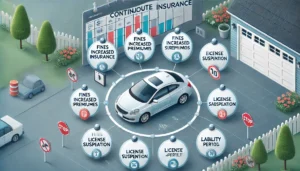how long can you be without car insurance
 As an independent insurance agent who’s been in the game for years, I’ve heard almost every car insurance question under the sun. But one keeps popping up, especially from folks in Arizona, Alabama, Florida, Georgia, New Mexico, New York, North Carolina, Oklahoma, Ohio, Texas, and Virginia: “How long can I go without car insurance?”
As an independent insurance agent who’s been in the game for years, I’ve heard almost every car insurance question under the sun. But one keeps popping up, especially from folks in Arizona, Alabama, Florida, Georgia, New Mexico, New York, North Carolina, Oklahoma, Ohio, Texas, and Virginia: “How long can I go without car insurance?”
Now, I get it. Times can be tough, and sometimes, you might be tempted to let that coverage lapse, even for a little while. But let me tell you, as someone who’s seen the good, the bad, and the ugly of insurance situations, going without coverage is like driving on a road full of potholes – you might make it through unscathed, but the risks are just not worth it.
In this article, we will dive into the nitty-gritty of car insurance gaps. We’ll explore why continuous coverage is so important, what can happen if you let it slip, and some clever ways to keep yourself protected, even when the budget’s tight. So buckle up, and let’s take this journey together. Trust me, by the end of this, you’ll be an expert on navigating the twists and turns of car insurance coverage!
The Risks of Driving Uninsured
Driving without insurance isn’t just a gamble – it’s like playing Russian roulette with your financial future and legal standing.
Here’s the real deal:
Legal Consequences
In all the states we’re talking about – Arizona, Alabama, Florida, Georgia, New Mexico, New York, North Carolina, Oklahoma, Ohio, Texas, and Virginia – driving without insurance is against the law. Period. If you’re caught, you’re looking at some serious penalties:
– Hefty fines that can run into hundreds or even thousands of dollars
– Suspension of your driver’s license
– Possible vehicle impoundment
– In some cases, even jail time for repeat offenders
Financial Risks
Now, let’s say you’re in an accident while uninsured. Brace yourself, because it can get ugly:
– You’re on the hook for all damages and injuries you cause
– Medical bills, property damage – it all comes out of your pocket
– If you can’t pay, you could be sued and have your wages garnished
Long-Term Consequences
The ripple effects of driving uninsured can haunt you for years:
– Your insurance rates will skyrocket when you try to get coverage again
– You might be labeled as a high-risk driver, making it harder to find affordable insurance
– Some companies might refuse to insure you altogether
The Hidden Costs
There are other ways driving uninsured can bite you:
– In some states, you lose the right to sue for damages if you’re hit by an insured driver
– You might be required to file an SR-22, which is basically a scarlet letter for your driving record
Look, I get it. Insurance can feel like a burden sometimes. But trust me, the alternative is much, much worse. It’s not just about following the law – it’s about protecting yourself, your assets, and your future.
If you’re struggling with insurance costs, come talk to me. At Blake Insurance Group, we can explore options to keep you covered without breaking the bank. Remember, a little coverage is always better than no coverage at all.
Stay safe out there, and keep that insurance up to date. Your future self will thank you for it.
State Requirements for Continuous Coverage
Here’s an overview of how different states handle continuous auto insurance coverage requirements and monitor for lapses:
State Monitoring Systems
Many states have implemented electronic verification systems to monitor insurance coverage in real time:
States like Alabama, Arizona, Georgia, and New York use online insurance verification systems that allow them to check a vehicle’s insurance status at any time.
– Insurance companies must report policy changes, cancellations, and new policies to these state databases, usually within 7-30 days, depending on the state.
– This allows states to identify vehicles that have had a lapse in coverage quickly.
Consequences of Lapses
States impose various penalties for letting auto insurance coverage lapse:
– Most states will suspend the vehicle’s registration if a lapse is detected. The registration remains suspended until proof of new insurance is provided.
Many states also impose fines, ranging from $100 to $1000, depending on the state and length of the lapse.
– Some states like Alabama and Georgia will suspend the driver’s license and vehicle registration.
– Repeat offenses often result in higher fines and longer suspension periods.
Minimum Liability Requirements
While specific amounts vary, most states require drivers to maintain liability coverage with limits in this general range:
– $25,000 bodily injury liability per person
– $50,000 bodily injury liability per accident
– $25,000 property damage liability per accident
Some states, like Florida, have lower minimums, while others, like Alaska and Maine, require higher limits.
Continuous Coverage Expectations
States generally expect drivers to:
– Maintain continuous coverage on any registered vehicle, even if it’s not driven.
– Notify the DMV if a vehicle will be uninsured for an extended period (by turning in plates in some states).
– Provide proof of new insurance immediately if there is a lapse or policy cancellation.
– Carry proof of insurance in the vehicle at all times.
Reasons for Strict Monitoring
States monitor insurance coverage closely for several reasons:
– To reduce the number of uninsured motorists on the roads
– To ensure drivers can cover damages if they cause an accident
– To protect accident victims from being stuck with unpaid medical bills and vehicle repairs
– To encourage responsible driving and vehicle ownership
The strict requirements and monitoring systems are designed to minimize insurance lapses and maintain high rates of insured drivers on the roads. While specific rules vary, the overall goal across states is to enforce continuous auto insurance coverage.
How to Avoid Lapses in the Future
Let’s talk about keeping that insurance coverage rock-solid without any pesky lapses. As your friendly neighborhood insurance agent, I’ve seen folks struggle with this, but I’ve also helped many stay on track. Here are some tried-and-true tips to keep your coverage continuous:
Set Up Automatic Payments
This is a game-changer, folks. I can’t tell you how often I’ve seen a lapse simply because someone forgot to mail a check or missed an email reminder. Here’s what you can do:
– Most insurance companies offer auto-pay options. It’s usually as simple as linking a bank account or credit card.
– If you’re worried about overdrafts, set the payment date right after your payday.
– Some companies even offer discounts for setting up auto-pay. It’s a win-win!
Work with an Agent (Like Yours Truly)
I’m not just saying this because it’s my job. Having a dedicated agent can make a difference:
– We can help you find more affordable options if you’re struggling with payments.
– We’ll monitor your policy and give you a heads-up if there’s a lapse risk.
– If you need to make changes, we can help you without interrupting your coverage.
Explore Pay-Per-Mile Options
If you’re not driving much, why pay for full-time coverage? Some companies offer pay-per-mile insurance:
– You pay a base rate plus a per-mile rate.
– It can be significantly cheaper for low-mileage drivers.
– Just be sure to estimate your mileage to avoid surprises accurately.
Bundle Your Policies
If you have multiple insurance needs, bundling can save you money and make payments easier:
– Combine auto with home, renters, or life insurance.
– You’ll often get a discount and have fewer bills to keep track of.
Set Calendar Reminders
Even with auto-pay, it’s good to stay on top of your policy:
– Set reminders a week before your policy is set to renew.
– This gives you time to make necessary changes or shop around if needed.
Maintain a Good Credit Score
In many states, your credit score can affect your insurance rates:
– Pay bills on time and keep credit card balances low.
– A better credit score often means lower insurance premiums, making it easier to maintain coverage.
Consider a Higher Deductible
If you’re struggling with premiums, raising your deductible can lower your monthly costs:
– Make sure you can afford the higher out-of-pocket cost if you need to make a claim.
– Set aside the difference in monthly premiums to build up your deductible fund.
Communicate with Your Insurer
If you’re having financial difficulties, don’t just let your policy lapse:
– Many insurers offer grace periods or payment plans if you’re upfront about your situation.
– Some may even have hardship programs, especially since the pandemic.
FAQs About Car Insurance Lapses

Blake Nwosu
Owner & Principal Agent
Expertise: All personal and commercial line insurance, including auto, home, business, health, and life insurance.
License: 16117464
